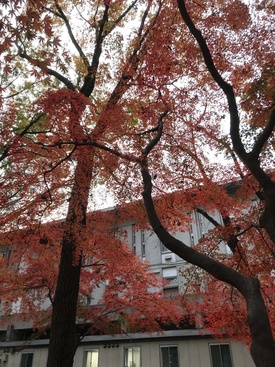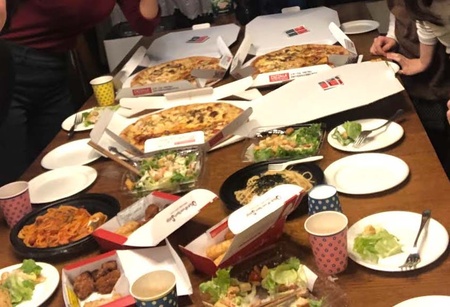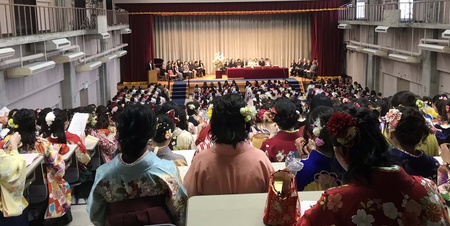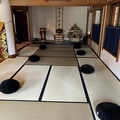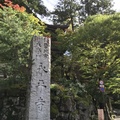“So what kind of person do you think the author is?” I asked the students in my class at an elite women’s college in Tokyo. Crickets. “Does the text suggest her ethnic or class background?” More crickets, faces cast downward or blankly staring at me. “How might our interpretation of the reading change if she was Asian American, black, or a mixture of both?” Crickets drowned out by cicadas, whose rhythmic pulse-buzzing resounded on this hot-sweaty Japanese summer day.
I’m exaggerating slightly the silence in my classroom—some students did raise their hands to answer questions or ask their own. But most lacked the willingness to do something my American students almost always did. I wondered whether language inhibited their participation, and so I encouraged them to reply in Japanese with other students translating into English. It didn’t make any difference. A Japanese colleague confirmed that language had little to do with my silent classroom while bemoaning the fact that Japanese were not as comfortable as Americans at expressing their own original thoughts.
The fellowship that brought me to Japan sought to advance international understanding and goodwill like the countless exchange programs that send students, researchers, and youth sports teams both ways across the Pacific. But there was one crucial difference—here the movement went in only one direction.
The US government sent professors like me to Japanese universities as visiting lecturers but brought no instructors from Japan to teach in our country—not even those fluent in English like my friend Yujin. Critics of the visiting lecturer program might fault it for embodying the asymmetrical notion that Americans have important things to teach the Japanese but that they don’t have equally worthwhile things to teach us.
I didn’t see it that way because our Japanese hosts and students welcomed us with open arms and were as hungry and appreciative to learn about the US as we were to learn about Japan. Moreover, we Americans didn’t shy away from discussing our country’s many shortcomings, which in my case centered on racial prejudice and inequality. In this way, I embraced the fellowship program’s mission to Americanize the Japanese even as I sought to become more Japanese in turn.
My main goal was to combat group conformity in Japan, particularly the well-known aphorism—“the nail that sticks up gets hammered down.” I had read that Japan was a group-oriented society, as opposed to the individually oriented West; and this was confirmed in seemingly every movie I watched that featured kamikaze pilots or salarymen sacrificing themselves for the greater good of the nation or company.
Moreover, I had experienced the pressures of group conformism myself as a Japanese American. At crucial moments in my youth when I asserted my own individuality, I faced retribution from ethnic peers for behaving like a stupid hakujin. Yet as I became an adult and ventured beyond my insular ethnic bubble, and especially as I learned about Min Yasui, Fred Korematsu, Gordon Hirabayashi, Mitsuye Endo, and others who risked their neck to resist their unjust wartime confinement, going against the grain became a kind of ideology for me.
As a visiting lecturer, I was convinced that teaching about these resisters and others who opposed racism would offer my Japanese students important lessons for appreciating and empowering racial minorities and respecting their rights.
For my first class at the women’s college, I arrived early to rearrange the heavy desks into a circle. Rather than sitting in rows looking at the instructor, the students were now able to see each other and talk freely as equals, reducing the conventional student-teacher hierarchy. Sitting in this way was so common back home that desks at my university rolled on wheels to ease rearrangement.
The current generation of young Americans has been trained from an early age to articulate and trust their voices. I recall a popular book and video series that my kids enjoyed in which Ms. Frizzle takes her students on far-out adventures traveling through time and space in a “magic school bus.” She cheerfully encourages them to “take chances, make mistakes, and get messy.”
Judging from the silence in my Japanese classroom, there didn’t seem to be a Ms. Frizzle character in Japan. As a result, I myself sought to fill the void—and not just by encouraging classroom discussion. I invited my students over for a pizza party. Such an informal gathering, I reckoned, might be another way to flatten the hierarchy between them and me and thereby inspire more classroom participation.
On the evening of the party, I set out the food and drinks and waited for the students to arrive. Once they all had gathered in my living room, I gave the sign for everyone to eat. I expected that each young woman would grab a slice of pizza, pour a drink, and dig in. That’s what my students in L.A. would do. But not in Japan.
Instead, they divvied up tasks and got to work. One parceled out pizza slices, another chicken and potato wedges. The salad servers squirted pre-packaged dressing on containers of lettuce and cherry tomatoes, while the beverage team filled paper cups 3 x 3 square—Coke in one row and cold oolong tea in others. The remaining classmates asked each of us for our drink and pizza preferences—pepperoni with marinara sauce or mentaiko (spicy, marinated fish eggs) with seaweed and mayonnaise sauce? I was served first, and before eating we all toasted kanpai and said itadakimasu with hands together.
The coordinated effort returned after dinner. Some students gathered leftovers; others emptied and stacked pizza boxes, used plates and cups. One stuffed the waste items into the large delivery bags. The resulting collection of trash looked like the food had been returned to its original packaging. Even our used chopsticks were slipped back into their paper sleeves, looking so tidy that I feared mistaking them for new ones if they were left around the house.
Meanwhile, other students returned chairs to the dining room, wiped the tabletop, and straightened the couch pillows—if I had had a vacuum and mop, I’m sure they would have been used. In the end, my unit looked like the cleaning crew had just swept through.
There’s no doubt that gender played a role in my students’ remarkable teamwork. But I’m not sure that a group of young Japanese men wouldn’t have still served me first and after eating taken pains to tidy up. And I knew from teaching at other Japanese universities that both men and women were reluctant to crawl out on a limb and express whatever was on their mind, despite my many and varied encouragements to do so.
After our pizza party nothing really changed in my silent classroom at the women’s college, save for my learning that all but one of the students sought to work in a “trading company” after their upcoming graduation. While women in my classes back home possess all manner of career ambitions (doctors, lawyers, researchers, screenwriters, entrepreneurs, etc.), it was curious to me that their Japanese counterparts sought the exact same entry level-corporate positions.
This comparison is not quite fair given that my students in Japan were all English majors—which was not the case back home—but even so the uniformity of their career ambitions struck me as the hallmark of a group-orientated culture.
A month after my class ended, I caught up with some of my students after their graduation ceremony, amid the crush of gaiety and family picture-taking. It turned out that nearly all of them had gotten jobs at various trading companies.
When I asked what they did during the break before graduation, one said that she had just returned from a vacation in Hawaii that she had talked excitedly about at our pizza party.
Another mentioned getting a driver’s license, which she thought might come in handy for her new job. She had spent two thousand dollars for a two-week study excursion at a far-away driving school. The price included a round-trip bullet train ticket, housing, meals, driver training classes, and individual driving instruction. The trip culminated with the driver’s test, which the student had passed.
What a strange thing, I thought—a sleep-a-way camp to obtain a driver’s license. This fit my view of conformist Japan where everyone was seemingly being trained in lock-step to do something—whether driving cars, cramming for school or university entrance exams, practicing tea ceremony, or even learning hula dancing. It seemed so different from the US, where we learn to drive not at a formal school but with parents, older relatives, or friends as our teachers.
The idea of an all-inclusive experience in a far-off location to obtain a driver’s license was laughable. But it became less funny the more I thought about it. Hadn’t I paid five hundred dollars each for my teenage sons to take twenty hours of mandatory driving lessons? The fee included online prep for their learner’s permit tests, but at least I supervised their fifty hours of driving practice that was required before they could obtain a driver’s license.
I don’t think there were sleep-a-way camps for getting driver’s licenses in the US, but if there were, would it have been worthwhile to send my sons away for two weeks? Let’s add up the costs. As I said, I paid five hundred dollars each for driving lessons, and then spent fifty hours per son supervising their driving practice. The supervision comprised more than one regular work week for each son (not counting the emotional toll it took on me to supervise inexperienced teenage drivers—one of whom, much to my chagrin, wanted to blast music while driving!)
Another consideration: the exorbitant added cost for car insurance during the time it took each son to complete the required hours of training, which took six months for one of them. By my calculations, it wouldn’t have been such a crazy idea to have sent my sons to a driving school like the one my Japanese student attended. So why did I smirk when she recounted her experience?
It turns out that when something flummoxed me about Japan I saw it as evidence of that country’s inferiority to the US. Here was the taproot of my wanting Japanese students to speak more freely in class, cut their own career paths, and learn to drive like we do in the US. Perhaps most Americans would have had the same reactions as I did to expressions of group-orientation in Japan; but as a Japanese American mine also contained an element of shame.
In the US, I wanted to fit in to the culture of individualism and was pleased that my kids grew up learning to speak their minds and had seemingly never been victimized by racial discrimination. They could experience the freedom of whiteness in a way that I couldn’t given my upbringing as someone who was made to feel the stigma of his racial difference. Likewise, they could appreciate Japan without feeling that its group-oriented culture had anything to do with them. I couldn’t do this. As much as I loved Japan, I dismissed signs of group orientation over there as embarrassingly un-American.
Seen in this light, my Japanese students taught me a valuable lesson about the limits to Americanization in Japan. As much as they admired the US as the global hegemon and as useful as I could be as a foreigner training them to express their individuality, they retained their own sense of collectivism that I came to appreciate through their remarkable teamwork in serving food at our pizza party and consideration for me in cleaning up afterwards. And through my student who went to the driving school I learned another crucial lesson:
My missionary tendencies and past racial insecurities prevented me from appreciating both group-orientated and individual-oriented cultures—one not any better than the other.
© 2023 Lon Kurashige


